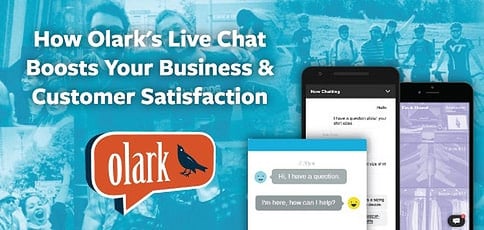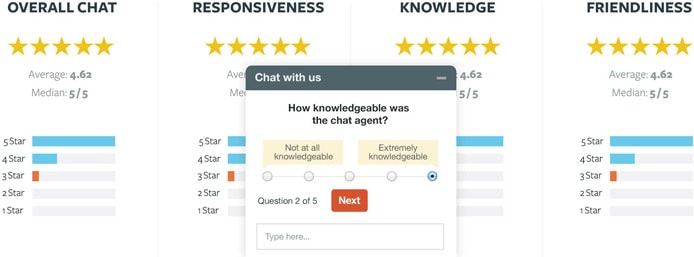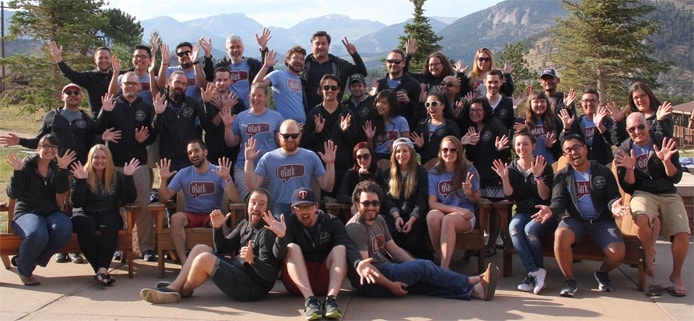
TL; DR: Ben Congleton learned the importance of customer service while running a successful hosting company with his high school buddies. Excited about making an impact and passionate about helping people, Ben left his PhD program to start Olark, a simple live chat tool that makes it easy for businesses to talk directly to their consumers. By being proactive with chat, companies can not only boost their sales but their user satisfaction rates as well. With a reputation for customer service, Olark users can build their brand around support and drive product development with consumer feedback.
One of those teenage web hosting entrepreneur phenoms in the late ’90s, Ben Congleton quickly learned the value of connecting with customers.
In the early days of AOL Instant Messenger and ICQ, Ben and his cousin Roland found a cumbersome live chat software that helped differentiate them from their competitors.
“As high school students, we didn’t have the 1-800 number,” Ben said. “Live chat was this really strong channel to communicate with our customers that helped us build a company.”
By the end of high school, Ben and his friends had built Netherweb into a company that generated $170,000 in revenue on only a $100 investment (Roland’s father gave them the money for the domain name). The hosting business took a back seat as everyone went off to college. Ben continued on to a PhD program and started a business building software for startup companies.
“We got to this point where we realized we liked building software products that we could control rather than being an IT development shop for people,” he said.
Ben and Roland revisited some of the problems they had had at Netherweb to see what they could solve. Live chat hadn’t changed much in 10 years, so an idea took shape — a lightweight, easy-to-integrate tool that was built for smaller teams.
The result was Olark, a live chat platform you don’t need a team of engineers or developers to install. Copy your Olark-generated code, paste it to your website, and immediately start connecting with customers.
“I like buying from people who care about me, and I want more companies out there to really excel at that,” Ben said. “The technology we have makes it a lot easier to do that than it used to be.”
Live Chat Boosts Conversion Rates & Builds Customer Relationships
According to Karl Pawlewicz, the Voice of Olark (yes, that’s his official title), implementing live chat can benefit a company in many ways: attracting new business and fostering deeper relationships with customers.

Olark’s reporting tools help companies gather feedback from their customers.
“We see a lot of companies want to use chat to improve their customer support first and foremost, but then they realize they can also increase sales and conversions,” he said. “Our platform provides a lot of information. You’ve got a whole range of different stats that you could look at in a couple of different ways to measure the impact live chat is having on your business.”
Acquia, the company behind Drupal, has seen $5 million in signups after conversations over Olark chat, according to an article by Acquia’s Head of Worldwide Inside Sales. Some other facts and figures that Karl gave us:
- Retailers have seen up to a 48% increase in cart size and three times better retention.
- Proactive chats, where a support agent reaches out first, earn a response 33% of the time.
- Automatic messages from so-called greeters raised a client’s conversion rates by 37%.
Once the conversation starts, Ben said the relationship a support agent can foster with a customer will have tremendous impact on whether they will return.
“It’s becoming easier than a phone call for a customer to engage with a company,” Ben said. “For me, what I care the most about is just helping more companies build brands with a very strong element of customer service.”
Hosting companies are a major Olark customer audience, according to Karl, because they understand the need for immediacy when it comes to support.
“When something isn’t working right, people need answers yesterday,” Karl said. “A customer might have been looking at seven different companies, but they bought with the company that gave them the peace of mind that, if things go sideways, they’re going to be there for them.”
Olark Features Gather Customer Input That Drives Product Development
Beyond sales, live chat helps companies get feedback on how to build better products or revise support procedures. You can gather analytics about who is on your site, what they’re looking at, and what’s in their shopping cart.
Quick & Easy Installation Lets You Chat in Minutes
Olark customers can put even more focus on support because the live chat system doesn’t need a team of engineers or developers to install and maintain.

Olark designed their live chat tool for small companies who don’t have major development teams.
“The thing we sort of invented early on was the idea that you could paste code onto your website and then immediately have live chat loading in the corner,” Ben said. “We made live chat a lot easier and a lot more accessible, which is really exciting.”
Instant Feedback Helps You Discover What’s Happening
Olark’s built-in reporting framework enables customers to rate each interaction. If a conversation was ranked poorly, you can look at the information to determine if the product, agent, or process is at fault.
“It’s really interesting how often an operator can be doing everything they can to serve a customer and there may be some policy or feature lacking in the product that still makes that poor experience for the customer,” Ben said.
Mobile Chat Enables You to Connect with Customers Anywhere
During the summer of 2016, Olark launched a redesigned and mobile-friendly version of their live chat program called Hummingbird that seamlessly integrates into mobile sites.
“The challenge was to strike a balance between web expectations and the limited real estate on a mobile screen,” Product Manager Joe Westhead said in an Olark blog post. “Hummingbird is small and non-intrusive, yet full-featured and fast. Visitors will now get the same web experience they’ve come to expect from Olark on mobile devices.”
Lean Team of Olarkers are #CHAMPS About Values & Remote Culture
Ben attributes Olark’s success to the quality of their employees, who actively participate in a thriving remote culture.

Olarkers revisit their core values at the annual company retreat. In 2016, the team traveled to Estes Park, Colorado.
“The #1 reason for our success is just the quality of our people,” Ben said. “The ability to recruit remotely across the entire US, Canada, and internationally has allowed us to hire a really amazing group of people who you would never find in just one location.”
Once a year, the global group of Olarkers gathers for a company retreat to discuss, shape, and adapt the company’s core values. Abbreviated CHAMPS, they stand for:
- Chill out
- Help each other
- Assume good faith
- Make it happen
- Practice empathy
- Speak your mind
“It’s really more of a bottom-up approach from our team to define the kind of company we want,” Ben said. “At Olark, it has always been a collaborative process.”
The majority of the 42-person team is focused on the Olark product, engineering, and design. Roughly once a month, however, employees will hop into Olark’s own live chat portal to answer customer questions.
“I think what that does is build empathy for our customers and empathy for our customer service team,” Ben said. “That is such an important part of our brand and the business we run. We’ve tried very hard to be aspirational around customer service to show other companies what a focus on customer service can do for their business.”
Ben’s Renewed Dedication to Customer Service via Lightweight Live Chat
Before Olark, Ben enjoyed his PhD program. He had a great group of friends and enjoyed his research into configuration management for the Internet of Things.
“It was really exciting, but it felt like we didn’t have that much potential to make a big impact in the world,” Ben said, recalling how an early blog post he wrote for the hosting company was read by several thousand people; his academic papers would reach only a few dozen.
The hosting company he helped start in high school became a passive business before eventually being sold. Customer support had dropped dramatically, which Ben later wrote in a blog post was “one of the biggest mistakes we made.”
That residual regret formed the inspiration for Olark — and confidence to make it happen.
“I was really confident that if we just sat down and worked, we’d be able to bootstrap the company into something real,” Ben said. “The other way I looked at it, if the company were to fail, I could always go back and finish the PhD.”
HostingAdvice.com is a free online resource that offers valuable content and comparison services to users. To keep this resource 100% free, we receive compensation from many of the offers listed on the site. Along with key review factors, this compensation may impact how and where products appear across the site (including, for example, the order in which they appear). HostingAdvice.com does not include the entire universe of available offers. Editorial opinions expressed on the site are strictly our own and are not provided, endorsed, or approved by advertisers.
Our site is committed to publishing independent, accurate content guided by strict editorial guidelines. Before articles and reviews are published on our site, they undergo a thorough review process performed by a team of independent editors and subject-matter experts to ensure the content’s accuracy, timeliness, and impartiality. Our editorial team is separate and independent of our site’s advertisers, and the opinions they express on our site are their own. To read more about our team members and their editorial backgrounds, please visit our site’s About page.

